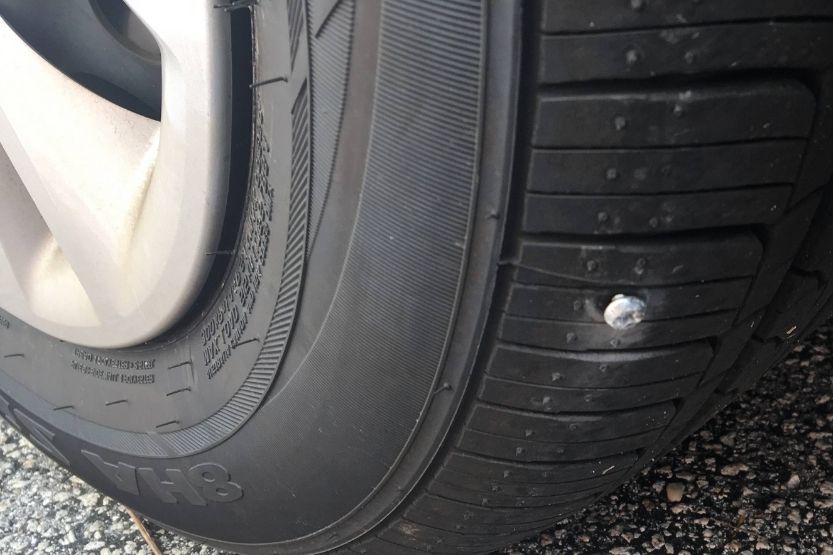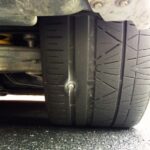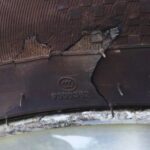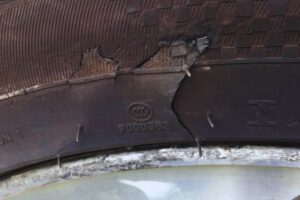Most drivers experience getting a nail in their tire at some time. It’s frustrating, but you can resolve the issue quickly if you know what to do. If you find a nail in a tire, what should you do?
If you are only driving a short distance, like no more than a couple of miles, you may be able to reach your destination with a nail in your tire. The nail might be helping by plugging up the hole created in the first place, but if the puncture is leaking air, you need to take out your spare and replace the flat tire.
Read on to learn more about what you need to do when you have a nail in your tire.

Can You Safely Drive with a Nail in Tire?
Although it is important to get your tire fixed as soon as you discover a nail in it, is it safe for you to drive your car to the nearest automotive service center?
Personally, I would never drive with a nail in my tire unless it happened while I am in the middle of a freeway, and I know that there is a service center nearby. Other than that, it is highly recommended not to drive with a punctured tire.
Driving on a tire with a nail can aggravate the damage it already caused, but if you have no other choice, then you can continue driving. However, you need to be extremely careful when you do so. Do not drive too fast, so you will still be in control if the tire fails catastrophically.
Whatever you do, though, do not pull the nail out yourself. It may be the only thing that is still keeping the air inside the tire.
How Does a Nail Puncture Your Tire?
How is it that a nail lying flat on the road was able to puncture your tire in the first place? The answer is that you are just plain unlucky. A thousand other cars could have run over the nail on the road, and it did not end up puncturing their tires.
It is crucial to meet a few conditions before you finally say that the nail punctured a tire. If it happens to you, then you were just unlucky to be in the wrong place at the wrong time.
On the other hand, it’s also possible that someone purposely punctured your tire. If that’s what you’re suspecting, then it is advisable to report the incident to the nearest police station.
What Happens If You Flatten a Tire with a Nail?
Reasons Not to Drive with a Nail in Your Tire
You might have your own reasons to want to continue driving even though there’s a nail on one of your tires.
However, there are also reasons why you should avoid doing so – among which are:
The Potential for a Blowout Is High
Running on a punctured tire increases the chance of a tire blowout. It is when the tire literally blows to pieces. A tire blowout increases your risk of losing control over your vehicle and potentially harming the other cars and pedestrians on the road.
If you need to drive on a punctured tire, do so with increased caution. Do not drive at the speeds that you usually do, and park your vehicle as soon as humanly possible.
More Damage to Your Vehicle
Even if you are careful, driving on a punctured or flat tire can mess up your car. The most obvious damage you can cause is on the wheels. Note that without the tires supporting it, the vehicle’s weight can cause the rim to bend out of shape or even fracture. You can also cause a lot of expensive damage to your car’s suspension.
What to Do When You Find a Nail in Your Tire
1. Confirm That There Is Indeed a Nail in Your Tire
You should first confirm that there is indeed a nail in your tire. The most obvious sign is that the tire keeps losing tire pressure, even after you pump it full of air using a compressor. If you find that the valve is not leaking air and your tire’s sidewalls are in good shape, the only logical conclusion is that something has punctured your tire.
2. Examine If There Is Anything Out of the Ordinary on the Tire’s Surface
Carefully jack your car up enough that you can spin the wheel using your hands. Carefully examine if there is anything out of the ordinary on the treaded surface of your tire. Usually, the head of a nail that punctured a tire would be somewhat shiny as the road surface would have ground it down to the bare metal. With that said, look for anything shiny.
3. Don’t Pull the Nail Out
Once you found the offending nail, do not pull it out. The nail might be the only thing that is keeping all the air inside the tire from escaping. If you have a spare tire, then change it immediately. If you do not have one, then you need to decide whether you can still drive to the nearest service station or have a tow truck take you there.
Is Nail in Tire Repair Still Possible?

There are many instances wherein you can still have a nail-punctured tire repaired. However, it will highly depend on the extent of the damage and the location of the hole. The amount of time you have driven on the damaged tire because the nail could make the damage worse over time.
Regarding the puncture location, you are generally fine if the nail went through the tire’s treads. You might not even need to do any repairs if the nail is small and only went into the thick part of the tread.
Now, if, for some reason, the nail went through the sidewall or came dangerously close to it, then it is best to get a new tire. Many tire repair shops would not even consider repairing punctured side walls as it means that once the nail went through the sidewall, it already compromised the entire tire’s integrity.
Can You Repair a Tire with a Nail in the Sidewall?
Technically, yes, you can. However, you will need to relegate the tire as a permanent spare as it is no longer reliable for long drives.
In any case, even if you just replaced the tires on your car with a whole new set, it will never perform quite like the other tires in the set, in case one of the tires got a nail put through it.
First, plugging the hole will allow air and moisture to get in between the layers and cause the steel radial belt to corrode. Moreover, even with a good plug-and-patch job, there will always be a slow leak coming from the repair.
Nail in Tire – How Long Will It Last?
In most cases, having a nail stuck in the tire means that the same nail prevents the air from leaking completely. However, note that it will still gradually leak out, so it is necessary to have it repaired.
Once punctured by a nail, a tire will already be in a compromised state. Even if you have it repaired, the question here is, will it still be useful at all. You need to figure out if your tire is still repairable or if you need to get new tires.
Here is a quick guide to give you an idea of what to do:
Location of the Hole
- If the puncture is in the tread area, then opt for repair
- If the puncture is in the sidewall, then replace the tire
Size of the Puncture
- Less than ¼” – repair
- More than ¼” – replace
The Extent of the Damage
- One or more punctures that have at least 16” between them – repair
- Multiple puncture holes grouped close together – replace
Signs of a Compromised Tire

The longer you leave the nail in your tire while still using your car regularly, the more you increase the risk of the tire exploding on you and causing you to figure in a major accident.
To make sure that you remain safe while driving, here are some of the signs that you need to keep an eye out for, so you will know beforehand if you need to have your tires checked out:
1. Tires Constantly Losing Air Pressure
If you drive a recent model vehicle, it might have a tire pressure monitoring system that will warn you if one of your tires is seriously underinflated. If you notice that one of your tires is somewhat constantly getting deflated faster than the other three, then it might have a puncture.
Without a TPMS, you can use a pencil gauge to check each tire’s tire pressure manually. Ideally, you should check your tires’ air pressure every other week or every month.
2. Steering Feels Off
If you have a flat tire, especially if it is any one of the two in front, you will notice your steering wheel pulling to the right or left. In that case, there might be a tire that’s underinflated.
3. Reduced Acceleration
An underinflated tire will take a lot more effort to roll on the road. The reason is that it tends to drag over the ground. It even worsens if you are running on a flat tire, which means you are basically running on the wheel’s rim. Not only will the engine have a harder time pushing the car forward, but you are also ruining your rim and potentially damaging the wheel bearing and the suspension.
4. Tire Appears Flat
The telltale sign is a flat tire. If you have a nail in your tire, and it isn’t completely plugging up the puncture, it will gradually release the air inside. If your tire seems normal when you came home in the evening, it may be completely deflated the following morning.
When you see these signs, you need to jack up your car and change the flat (or almost flat) tire and have it fixed as soon as you can. Never travel anywhere without a spare tire on the ready.
Helpful Precautions and Preventive Measures
As mentioned earlier, you need to fulfill many conditions for a nail lying down on the road to puncture your tires. However, remember that it does happen quite often, and you cannot predict when it will happen to you.
Fortunately, there are certain things that you can do to prevent getting a flat tire due to running over a nail:
1. Use a Tire Sealant
Tire sealants are great because they automatically plug up punctures in your tires. Just make sure that what you are using is not too big. When a nail punctures the tire, the air pressure inside it will also push a bit of the sealant through the hole. It will then proceed to plug up the opening.
2. Utilize Puncture-Resistant Strips
Just like tire sealants, you stick this product inside the tire before mounting. It works similarly to tire sealants, though this one is faster and capable of handling significantly more damage. You need to lay down the strip inside the tire and just underneath the treads.
3. Get Puncture-Resistant Tires
These tires are basically just regular tires but with the sealant already built into them. Although these tires are much more expensive than regular ones, they are much more durable. So, they are worth checking out, at least.
Conclusion – Nail in My Tire
You can drive with a punctured tire. If you’ll only be driving a short distance and the tires still have enough air, then you can probably get to the nearest service center. Just make sure that you drive carefully. If you’re lucky and the nail is positioned in such a way that it prevents air from escaping, then you can give it a shot.
However, it is not usually advisable to drive your car with a nail in the tire. Unless you have no choice in the matter, you really should avoid attempting it.
Again, here are quick tips to prevent a flat tire, in case of a nail in tire:
- Use A Tire Sealant
- Utilize Puncture-Resistant Strips
- Use Puncture-Resistant Tires
For your reference, here are the signs that you need to have a mechanic check your tires:
- Tires Constantly Losing Air Pressure
- Steering Feels Off
- Reduced Acceleration
- Tire Appears Flat
Related reading:
How Long Can You Drive on a Tire with Fix-a-Flat?
Screw in Tire (Leak or No Leak) – What to Do?
Low Tire Pressure Light On But Tires Are Fine [Why Is This?]




![How Much Does Paintless Dent Repair Cost? [Full Guide] how much does paintless dent repair cost](https://roadsumo.com/wp-content/uploads/2022/05/how-much-does-paintless-dent-repair-cost-150x150.jpg)

![Scratched Rims Repair Cost [How Much to Fix a Scratched Rim?] Scratched Rims Repair Cost](https://roadsumo.com/wp-content/uploads/2021/10/scratched-rims-repair-cost-150x150.jpg)


